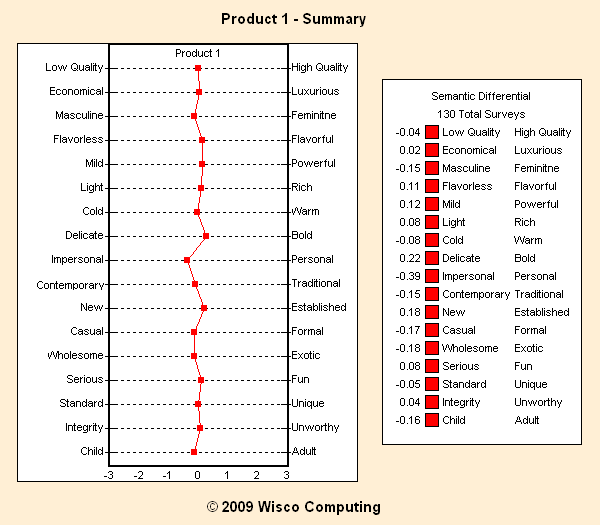Create, Collect, and Analyze Surveys and Web Forms

Semantic differential questions measure people's attitude toward stimulus words, objects, and concepts. This question type consists of a series of contrasting adjective pairs (e.g., good-bad, beneficial-harmful) listed on opposite ends of a bipolar scale. Many studies have shown that semantic differential questions can work effectively with different age groups, cultures, and languages. These questions are popular because they are extremely easy to construct and administer, and provide reasonably valid and reliable quantitative data.
Semantic differential has been successfully applied to marketing, personality measurement, operations research, clinical psychology, and cross-cultural communications. Semantic differential questions are probably the most common question type used for marketing surveys and experiments. It is used to evaluate products and services, measuring brand attitude, ad credibility, etc. These questions are also used for employee surveys, salary surveys, and customer satisfaction surveys.
The stimulus is identified at the top of the scale and may be a word, phrase, statement, or picture. An example:
On each scale, rate your feelings toward --------. There are no correct answers. Also, some of the scales seem to make more sense than others. Don't worry about it. Please don't leave any scales blank.
Adjective pairs are selected according to objectives of survey. The adjective pairs can be grouped into 3 large categories. A survey question usually include a few pairs from each category. Following are some examples for each category.
- Evaluation (good-bad, positive-negative, pleasant-unpleasant, worthless-valuable, dirty-clean)
- Potency (strong-weak, heavy-light, hard-soft, simple-complex, submissive-assertive, difficult-easy)
- Activity (active-passive, excitable-calm, fast-slow, relaxed-tense, dim-bright, quiet-noisy)
Create Survey Question
- Enter survey question text.
- Choose question type 22 Semantic Differential.
- Enter up to 25 pairs of text choices. Use the & symbol to separate each pair of contrasting adjectives.
- Click the Options/Values tab.
- Semantic Differential questions can use values from -5 to 5. With the spinner, set the number to the maximum value.
- Enter Question Topic.

Collect Survey Responses
Usually the middle position of the scale is marked 0 or labeled 'neutral'. Most of the time, actual surveys use a scale with 5 or 7 divisions between each pair of contrasting adjectives. The farther a rating is from the middle indicates the intensity (slight to extreme) of the person's attitude.

Semantic Differential Charts
WISCO Survey Professional version creates semantic differential charts from the survey data.
